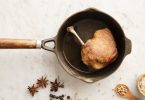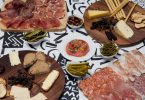Truffles are curious objects of seduction. They excite and provoke the senses. The mere whisper of their name elicits an immediate response. They make you want to study their size, admire their shape and depth of colour. They implore you to close your eyes as you inhale their pungent aroma. They make you quiver with excitement as you reach out and caress their skin, and gently squeeze one between your fingers.


Tasmanian Périgord Truffle
At a recent truffle, Chablis and Châteauneuf du Pape tasting at the Ultimo Wine Centre, we took home our first Périgord Truffle from Tasmania. The 29 gram nugget was wrapped in a paper towel and came in a spring-lidded glass jar to maintain freshness.


Truffle, Chablis and Châteauneuf du Pape tasting at the Ultimo Wine Centre
Australia is a recent producer of black truffles but sceptics need not dismiss new world truffières in favour of traditional tubers from France and Italy. As partial as we are to the French varieties, Tasmanian Périgord Truffles are well worth their weight.
Much like with their French counterparts, roots of oak and hazelnut trees are injected with fungal spores to produce the black truffle known as tuber melanosporum and truffle hunting dogs are used to sniff for the presence of these black diamonds.
We have previously compared black truffles from Périgord in France to Manjimup truffles in Western Australia so as home truffle enthusiasts, we were keen to put the Tasmanian cousin to the test.
The similarities between the Tasmanian and the French Périgord truffles were surprising. Both had similar depth of colour and a heady earthy aroma that lasted for two weeks when stored in an airtight jar in the fridge. Both had a relatively smooth outer skin and weren’t as dry to the touch or brittle when passed through the truffle shaver, as the Manjimup truffle from WA was on both counts. The marbling effect of the Australian tubers was a little more pronounced whereas the French was a denser black.
After two weeks storage, the Tasmanian Périgord didn’t grow any white mould on the surface. By the third week, the tiny piece left had little if any flavour which is far too long to keep any truffle.
When it came to taste, we found it difficult to grade the French and Tasmanian Périgord as both had that unmistakable earthy flavour that imparted equally well in the dishes we prepared.
Naturally, the comparison between the various truffles was not made at the same time and different harvests between the same variety can yield different results. But for the home truffle connoisseur and gourmand, the Tasmanian Périgord truffle is a serious contender.
Next in the truffle series – Cooking with Truffles
Other truffle articles:
Comparing Périgord and Manjimup Truffles
What to Do with a Truffle
Tasmanian Périgord truffles:
http://www.perigord.com.au/






[…] Other truffle articles: What to Do with a Truffle Périgord Truffles from Tasmania […]
[…] Other truffle articles: Comparing Périgord and Manjimup Truffles Périgord Truffles from Tasmania […]
Awesome. I’ve never cooked with truffles at home. I’m not surprised Tassie’s truffles are as good as you describe them. Some of the world’s best food comes from there, right? It’s a feat that they were able to grow them to start off with though. Excellent post. Looking forward for the “cooking with truffles” post.
Thanks Fouad. Now that we can get fresh truffles twice a year from France and Australia, we are a little spoilt 🙂
Hehehe. I still can’t afford either French or Tasmanian truffles, but I sleep better at night knowing they are there 😛
oops. meant to say neither/nor. totally apologies for murdering the English language
That was the royal ‘we’ as in ‘we in Australia’… not expecting a price drop at all because they are locally grown! 🙂
[…] This post was mentioned on Twitter by Sydney’s Best Cafes, Fouad Kassab and Fouad Kassab, Ms Gourmantic. Ms Gourmantic said: [New on G] Périgord Truffles from Tasmania http://bit.ly/drWMEQ #truffles #tasmania #australia […]
[…] Truffles were presented by “Mr Truffle”, Duncan Garvey of Périgord Truffles from Tasmania, an Australian grown tuber that we have previously […]
[…] you open a jar of truffles, let the aromas come to you. Just like perfume. Duncan Garvey of Perigord Truffles told a captive audience at the Truffle Hunt event with Secret Foodies and Alex Adams (Ms […]